#Korg M1R
Explore tagged Tumblr posts
Text


Created between 2020 and 2024, 'Music for Dystopian Concrete Buildings: The Future of Void Corp.' is a concept album project crafted exclusively with pre-year-2000 hardware synthesizers as an homage to dystopian 1990s ambient game soundtracks.
Production Resources: Roland JV-2080, E-mu Morpheus, Akai S1000, E-mu ESI2000, Waldorf Microwave 1 Rev A, Kurzweil K2500R, R.E.A. YM3812, Yamaha PSS-480, Korg M1R, Korg Wavestation A/D, Roland S-550, Elysia Skulpter 500, API 500VPR, UAD-2 Octo, Apogee Duet 2, Zoom H5. Full Production Notes: www.fornaxvoid.com/void.php?page=mfdcb
19 notes
·
View notes
Photo

I can't believe that this synth has been with me for over 30 years. I bought the Korg M1R when I got my record deal with BMG Records and it is still with me. I can't believe that this synth has been with me for over 30 years. I bought the Korg M1R when I got my record deal with BMG Records and it is still with me.
#BMG Records#Korg M1R#Logic Pro#M-Audio Keystation88#Mac#Man With A Gun#multi-effects unit#Music Workstation#record deal#recording#song#synth#Zoom Fire 7010
0 notes
Photo
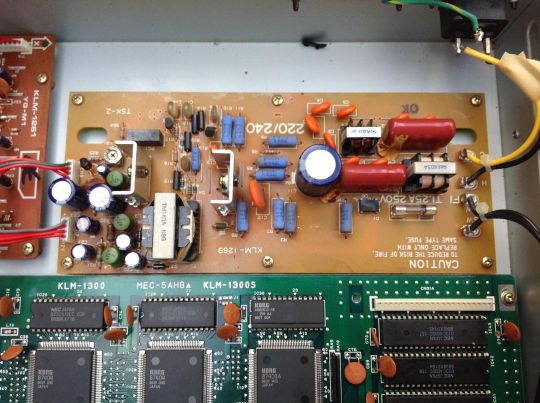
Happy Saturday. Now that’s 240v. Links to YouTube videos in Linkin.Bio 😉 #tmtgcommunity #themusictechguyuk #musictechguyuk #musician #vintagekeyboard #vintagesynthesiser #synthesiser #keyboard #happysaturday #korg #korgm1 #m1 #m1r #m1rpowersupply https://www.instagram.com/p/CaLRaN6tNF4/?utm_medium=tumblr
#tmtgcommunity#themusictechguyuk#musictechguyuk#musician#vintagekeyboard#vintagesynthesiser#synthesiser#keyboard#happysaturday#korg#korgm1#m1#m1r#m1rpowersupply
0 notes
Text
Happy New Schmear
Well, 2020 was a helluva clusterfuck-train-wreck-sewer-explosion-dumpster-fire of a year, and to be honest, 2021 ain't off to that great of a start really. Look at 'Murica. The trumpty-dumpties tried their inane, lunacy- and conspiracy theory-fueled "revolution" at the Capitol, and how'd that end up? Bunch of bearded, beer-bellied, barely literate, bandana-wearing bumpkins. Aaaargh! And Covid is on the rise here in Japan, so the gov has announced a second "state of emergency" but all they're doing is "asking" people to avoid unnecessary outings and for drinking/eating establishments to close at 8pm. We're doomed.
But, the gear quest continues! The B200 wasn't doing it for me, not enough control, so I said fuggit and bought a DX7II-D, the second one I've owned actually. Obviously, 6-op full control is miles ahead of what I was dealing with using the B200, but there are no Easy Edit features, so it's pretty much dive in with both feet, sink or swim. There are a few decent tutorials on youtube, especially the MadFame channel, and following those definitely helps get your head around the basic idea of how FM works. I'm no expert, but at least now I can think OK I want this kind of sound, and I have a feel for how to go about doing it, and can actually get close to what I had in mind, compared to before, when I had less than zero of a clue what to do. FM is nuts.
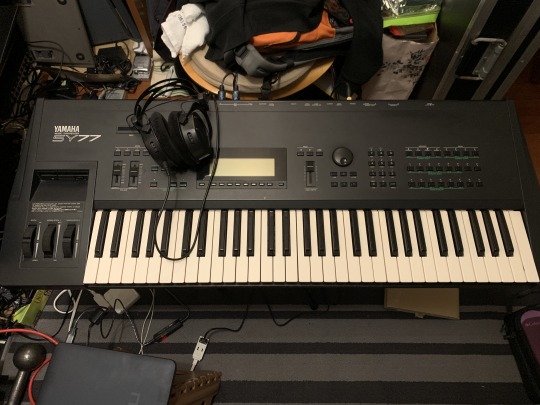
What a mess I had going when I took that photo. I wanted a TG77 but they were going for like $500 and up, and that was outta the already non-existent budget, so I saw this for $99 and thought, well? Spent another $90 getting a bright green replacement LCD, that is actually so bright, I can't see the buttons or the knob or anything. Madness! This is a helluva synth though. AFM is no joke. every operator has two inputs, and you can freely assign feedback loops. Shit, you can even write your own algorithm! Mental as fuck. Such a rich, deep sound too. I love this synth. Not too keen about the size, but there's always a compromise.
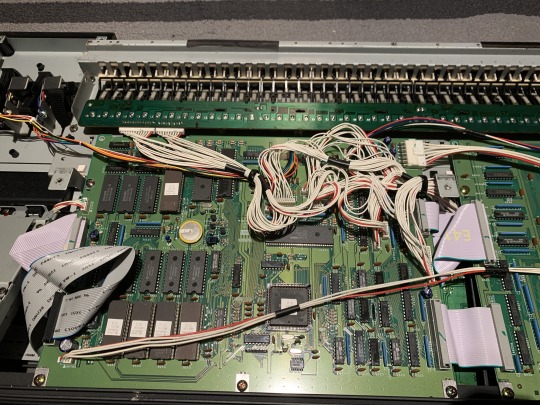
Replacing the LCD was a HUGE task. Not for the faint of heart, seriously. I followed Midera's video and that was a huge help. You literally have to remove EVERYTHING to get to the LCD. But at least the replacement was a plug & play drop-in replacement. I replaced the backup battery while I was in there. I can't remember if I replaced the tact switches... I've done that so many times on so many pieces of gear in the past half year that it's not even funny. Seriously. Today for example....

Tact switch highjinks on a KORG RE1. I picked up an O3 R/W, as I was getting the itch to use M1 sounds into my projects but didn't wanna deal with USB dongles and camera kits and all the associated iPad paraphernalia. So I bought an O3 R/W, and saw an RE1, remote editor, and was like YES, and bid an insane amount considering I'm really in no position to be spending money on this stuff right now, but luckily won the auction for $125. The tact switches were like NOPE, so I replaced them all, except for the A-H buttons under the LCD because those worked fine. 30-minute job and now it's good as new. Using the RE-1 I guess makes the O3 R/W (or the M3 as it works with that too) rather like an M1R as far as interface goes. I don't recall if the M1R has sliders, but I know it has the bigger (wider) LCD. Less pages to scroll through and you get a blurb that tells you what the parameter is you're editing displayed in the upper right hand corner. VERY happy to have gotten this.
In other news, I impulse bought an old Fostex 3070 compressor for shits and giggles and it's turned to tears and sniffles as the left channel is just not working right whatsoever. I've replaced all the caps, and socketed and replaced all the ICs except for one (the LM2309 comparator). And it was like NOPE. Cleaner, but still it was not functioning right and there was a huge difference in output levels between sides. So I think the comparator chip that I haven't replaced, on the left channel, is the culprit, as when I mess with the Expander/Gate switch and knob, all hell breaks loose. It's an odd chip though, they went with a 9-pin SIP (single in-line package) chip instead of a standard, 8-pin, DIP (dual in-line package) chip. The former is a chip that is long and skinny and has one row of 9 pins along the bottom, whereas the latter is a small black rectangle with four pins on either side. I did look at the schematics and saw that pins 1 and 9 are routed to +V, and that if you just shift pins so that 1 is left unconnected, the pinout will match a DIP chip. Aitendo to the rescue! They sell converter baby PCBs so you can pretty much change between any kind of IC format.
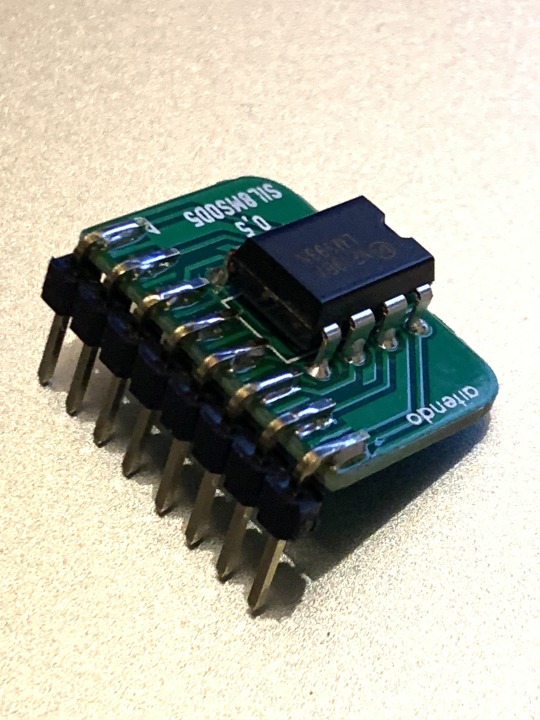
And that is the part in question. I'll put a socket on the PCB where the original chip sits, and see what happens. No great expectations but who knows. For the ultra tech savvy of yous out there, you'll know that a certain big name four-letter electronic act of the 90s used the 3070 and ran their whole mix through it. Hehehe. Yeah ok so that is basically what I had in mind, but who knows. If the thing comes back to life, we'll see...
I suppose that is pretty much it for now, my invisible, ethereal pals out there. Have fun!
2 notes
·
View notes
Photo

KORG M1R, JoMoX AirBase 99, CASIO RZ-1 drum sound mix demo https://t.co/UI04p3LSov http://twitter.com/yuzokoshiro/status/1439607099806216203
0 notes
Text
CatSynth Video: Korg M1 Modded circuit bent with Marcel
youtube
From polynominaldotcom on YouTube, via matrixsynth.
Just modded and bent the classic M1/M1r wavetable with 6 switches on the back of the machine. 5 sounds demo with circuit bent options. First 3 demo with normal Midi keyboard, In 2 others, the Mi1r is driven by an algorithmic generator module ‘Turing machine’. Generated patterns are midi converted with a Doepfer a-162 cv to MIDI module.
Very interesting to see a Korg M1 and M1R “bent” this way. And if that feline portrait looks familiar, it’s probably because you’ve seen it before. Eric of Polynominal.com and his cat Marcel are good friends of ours at CatSynth, and we have featured many of Marcel’s pictures.
var quads_screen_width = document.body.clientWidth; if ( quads_screen_width >= 1140 ) { /* desktop monitors */ document.write('<ins class="adsbygoogle" style="display:inline-block;width:600px;height:100px;" data-ad-client="pub-5176416568130778" data-ad-slot="2974773354" >'); (adsbygoogle = window.adsbygoogle || []).push({}); }if ( quads_screen_width >= 1024 && quads_screen_width < 1140 ) { /* tablet landscape */ document.write('<ins class="adsbygoogle" style="display:inline-block;width:600px;height:100px;" data-ad-client="pub-5176416568130778" data-ad-slot="2974773354" >'); (adsbygoogle = window.adsbygoogle || []).push({}); }if ( quads_screen_width >= 768 && quads_screen_width < 1024 ) { /* tablet portrait */ document.write('<ins class="adsbygoogle" style="display:inline-block;width:600px;height:100px;" data-ad-client="pub-5176416568130778" data-ad-slot="2974773354" >'); (adsbygoogle = window.adsbygoogle || []).push({}); }if ( quads_screen_width < 768 ) { /* phone */ document.write('<ins class="adsbygoogle" style="display:inline-block;width:600px;height:100px;" data-ad-client="pub-5176416568130778" data-ad-slot="2974773354" >'); (adsbygoogle = window.adsbygoogle || []).push({}); }
CatSynth Video: Korg M1 Modded circuit bent with Marcel was originally published on CatSynth
0 notes
Text
Klaus Benedek - forTunea Label mix (8DPromo)
Vienna’s rising forTunea label has released a cluster of quality tunes over the past year, and 2018 is filled with big plans and amazing new music. Label don Klaus Benedek has crafted an excellent DJ mix showcasing some of the label’s sounds from 2017 as well as output from artists in forTunea’s orbit. It’s a pleasurable dive into upfront deep house sure to get your seat swiveling. Have a listen:
We asked Klaus Benedek a few questions about forTunea, the house scene in Vienna, and this mix.
What inspired you to start the label, and when did it begin?
Klaus: I was tired of waiting for my tracks to get released. After signing contracts with various digital labels, it took about a year until my tracks finally came out. That's why I started my own label in 2014. And of course, I always wanted to release vinyl, too. At first I worked alone and there were only songs released by myself. But after a while I received demos from fellow local DJs/producers and so I signed them. The vinyl is always limited to 300 copies (except the first release "Still Daydreaming", 350 copies). If they are sold out, then they are gone. There will be no repress.
Tell us about the Vienna scene, specifically the underground house scene. How are you a part of it? Who are the standout artists? Who's making moves? Anything to let us know about what's happening in Vienna (or Austria as a whole) that makes it special right now.
Klaus: Clubbing in general got its boom since the Pratersauna opened in 2009. However you can't compare the nightlife with other metropolises like Berlin or Amsterdam. Venue owners have to follow regulations and they are strict. So do not expect massive sound systems in every location. They are mostly locked on a certain db limitation. Afterhours parties exist, but they only take place for a few hours. Other than that there is a closing time for bars till 4 AM and clubs till 6 AM.
Before the Pratersauna, electronic music was always more a niche market in Austria. In Vienna, we had only a couple of venues where techno, house, and, at that time, the minimal sound was played. Those were Flex, the Camera Club, the Fluc Wanne, and occasionally some huge, more commercial events in the Volksgarten and the Gasometer. Other than that, drum n’ bass, downtempo, and indie rock were more popular in the Austrian capitol. But since the beginning of the 2010s and the popularity of certain individuals and movies that became a pop culture phenomenon (such as Berlin Calling) that all changed. Techno parties are well attended now. Especially since more locations opened (Grelle Forelle, which has the best sound system in the city) or relocated (Werk) on the Danube channel.
The house scene in Vienna is relatively small compared to the techno/tech house crews. If you really wanna hear Chicago style, deep, garage, lo-fi house, or even disco you need to visit smaller locations like Celeste, Spark, Elektro Gönner, or Sass. Many fellow DJs have their home bases now. For example, Roman Rauch organises the event series Manifest - Spritzwein Session with Nico Nesta and Maaki for more than two years. It’s where you’re most likely to hear DJs that don’t come to Vienna regularly like Move D, Red Rack'em, Hunee, Fouk, and Terrence Parker. Besides forTunea there are a handful labels that have been established or had a breakthrough during this decade. You should check them out, regardless the genre: Luv Shack Records, Secret Crunch, Life Is For Living, Schenkelspreizer, Affine, Step Back Trax, Sama Recordings, Luv Lite Recordings, Morbid, Yoshi, Driving Forces Recordings, Footwork Frenzy.
What is on deck for 2018 for forTunea?
Klaus: In January my Consequences EP will be re-released digitally. After that we will expand our artist roster. In March we will finally release an EP by my good old friend Alex Kolodziej. I think it took almost two years for him to finish the tracks. That’s because he had almost no time. He works in catering and has a 60+ hour a week schedule. Appropriately the record will be called Workaholic. Peletronic and myself will deliver remixes too. In May/June Munich/Bavarian-raised Anatol, who has lived in Vienna for quite a while, will release a 12" vinyl single. And in summer we plan, for our 10th issue, an eight track compilation.
How does the philosophy of the label tie in with your DJ’ing and production?
Klaus: On forTunea not every release sounds the same, and we want to stick to this philosophy. The tenor is always house music. But it shouldn't be monotonous. We’ll release a deep house record, then the next one will have a disco vibe to it, and others will be more techy, broken beat, or with Chicago or Detroit influences. My DJ’ing is similar. I never liked to just play one (sub)genre the whole night. I upload a promo mix on my Soundcloud page bi-monthly to introduce new tracks/vinyl that I picked up and present them in a way that makes sense.
I am making music on Ableton Live, combined with Reason as a master/slave combination. Most of the time I use VST Plugins. But I also work with hardware pieces like a Waldorf Pulse, Microkorg, or my newest baby in the studio, a Korg M1R.
Tell us about this DJ mix.
Klaus: All tracks that I feature in this mix came out this year. Of course, you will hear some tracks that have been released previously on forTunea amongst other artists like Nick Höppner, Ponty Mython, Space Echo, and Demuja. I’d like to highlight Demuja! This guy comes from Salzburg and 2017 was definitely his year. He even released an EP on Jimpster's label Freerange Recordings. In this mix you will hear a track from his current EP on Life Is For Living. Enjoy!
0 notes
Text
Korg M1R-rack version of classic M1 with 2 vol manual
http://dlvr.it/PsSqfB
0 notes
Note
Hi! I wanted to ask what track is playing in the background of your video "Sampling HD Deskjet 500 to Akai S1000"? Thank you!
A post shared by Fornax Void (@fornaxvoid) on Aug 23, 2017 at 5:12pm PDT
Hi there! It is a track I’m working on for my next album. Here is a short preview of it. The DeskJet percussion samples haven’t yet been implemented.
#answer#akai#s1000#deskjet#electronic#ambient#music#synthesizer#sampler#yamaha#DX21#TG33#PSR-47#PSR-60#reface cs#oberheim#xpander#korg#m1#m1r#roland#jv-2080#tb-03#tb-303#casio#cz#cz-5000#Anonymous
53 notes
·
View notes
Text
Man With A Gun
If you listen to this song you may think that I am a little bit crazy, but the song Man With A Gun was inspired by movies rather than the desire to go around killing anyone.
I feel that this is one of my darkest and creepiest songs, it is a song about a sadistic killer. I don’t know where the inspiration for song came from, I am hoping it was inspired by the movies that I watched and not something dark in my subconscious. I love it because it taps into something strange. This song is not for everyone, I would hope that no one identifies with the character in the…

View On WordPress
#crazy#darkness#death#evil#gun#killer#Korg#M1R#movies#outlaw#recording#sadistic#song#vintage#zoomfire
1 note
·
View note
Video
youtube
Fornax Void - Corporate Intranet Menu Music Corporate Intranet Menu Music was recorded between 2018-AUG-29 and 2020-FEB-02. Initial composition steps found place inside renoise. The project was stuck with just 4 patterns for over 8 months, until most of the composition was finished between 2019-MAY-06 and 2020-MAY-29. The synthesizers I used within Renoise were the three Korg's Legacy plugins M1, WaveStation and Mono/Poly. For the initial mix in Renoise I mostly used native Renoise plugins with the exception of TAL Reverb 4, a free reverb plugin. Close to the end of the project (after the steps mentioned below), I also created slimmed version that fits on a floppy disk. After I finished composing in Renoise, I exported all the tracks as separate files and imported them to Cubase. There, I did some refinement as well as recording additional layers with the Roland JV-2080, Korg M1R, Yamaha TX802, Akai S1000 and E-Mu Morpheus to flesh out percussion details. In a second step I also added an additional synthesizer melody towards the end of the track using the Roland JV-1080. The percussion samples used on the Akai S1000 were sourced from my 1991 HP DeskJet 500C. These samples where initially recorded for use on the Cyberspace Database track 'SysAdmin Coffee Break Saga' but were never used on that track. The video for Corporate Menu Music was created between 2016-AUG-24 when I started on the first map and 2020-MAY-31 when I uploaded the final version of the video to YouTube. It took another couple of months until the video went public on 2020-OCT-14. All the mapping was done in TrenchBroom 1.1.6 Build 381 by Kristian Duske & Co. Close to all of the textures used were created by myself and added to Q.WAD with Wally Version 1.55B by Ty Matthews and Neal White. Compiling was done with ne_q1spCompilingGui v1.0.3 by C. Jones (‘necros’). Downloads and more Information: https://www.fornaxvoid.com/void.php?page=cimm
22 notes
·
View notes
Video
youtube
Fornax Void - Void Gate Panorama Station Void Gate Panorama Station was recorded from January to March 2018. Instruments used on this track: Roland JV-2080, D-05, TB-03, TR505, Akai S1000, S3000XL, Oberheim Xpander, Korg M1R, WaveStation A/D, Poly 800 MK2, Monotron Delay, Casio CZ-5000, Yamaha PSS-480, TG33, PSR-47, PSR-60, Reface CS, DX21, FB-01, Arturia Minibrute, Waldorf Rocket, REA YM3812 (OPL2), C64 with Mssiah, Wayfar MidiNES, Eventide Space. This video was created between March 2018 and December 2020 with Blender 2.79
2 notes
·
View notes
Audio

Cyberspace Database Version 1.0 is now on Bandcamp.
All tracks with new mixes and masters + 14 new tracks. Cyberspace Database is the result of a 5 years long exploration of Cyberpunk Ambient themes. A journey through the timbres of classic digital and analog synthesizers and samplers with focus on defining the pillars of the SemiconductorWave genre.
55 Tracks. Runtime: ~ 4 hours 47 minutes 43 seconds. Uncompressed 24bit 44.1 KHz WAV download available.
Pre-released on January 24, 2017 with 16 tracks, the album continuously grew and was released in its final version on February 2, 2020.
New Tracks: 3. Corporate Intranet Menu Music 8. Yoshimura's Journey 吉村 10. A Cubicle Tale 12. Nankyoku Data Hive 13. SysAdmin Coffee Break Saga 20. Cyberspace Druids 22. Remembering Johnny Castaway 38. Sector Restoration History 47. Kunshu Corporation Surveillance Center 48. Void Wizards Saga: Chapter 1 49. Void Wizards Saga: Chapter 2 50. Void Wizards Saga: Chapter 3 51. Void Wizards Saga: Chapter 4 55. The Lost Archives Instruments used on this album: Roland JV-2080, JV-1080, D-05 and TB-03, Akai S1000 and S3000XL, Oberheim Xpander, Korg M1R, M1 plugin, WaveStation A/D, WaveStation plugin, Volca Beats, and Poly 800 MK2, Casio CZ-5000, Yamaha PSS-480, PSR-47, PSR-60, Reface DX, Reface CS, DX21, FB-01, TG33 TR-505, TX802, Arturia Minibrute, Waldorf Rocket, REA YM3812 (OPL2), Commodore 64 (Mssiah), Wayfar MidiNES, E-MU Morpheus, MilkyTracker and others...
134 notes
·
View notes
Text
Fornax Void Update Spring 2019
Hey everyone,
In recent months I may have seemed kind of inactive, which led to a few requests about what I'm up to. I thought I might write a little update on what is going on:
For the most part I'm working on cleaning up my Album 'Cyberspace Database'. As I plan to release the Album on physical media this year (coupled with new videos), I want to refresh the mixes, and create consistent masters of all the tracks. This created the need to migrate my DAW to a computer with higher performance.
Making archival backups of all the data, migrating DAW to computer with more performance, upgrading Operating System, getting latest Cubase etc.
This took some time and the according purchases (HDDs, SSDs, Cubase License etc.) created Budget problems. I started doing more commissions and decided to sell all hardware synths except a handful of favorites - generally reducing clutter in my workspace, by selling stuff. This resulted in additional logistical, and administrational efforts: sampling all the synths, especially recording samples of important personal patches, creating online auctions, packing up things and hauling them to the post office etc. This process is not yet finished and will take up a couple more weeks.
Basically, I'm cleaning up and refreshing things, to wrap up my work of the last few years in a well rounded way.
For fun, I created a list of the synths I sold or kept, with statements on why and mentions of a couple of tracks they were used on:
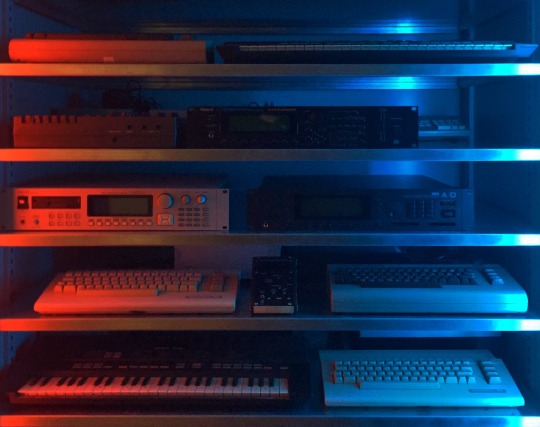
Kept:
Roland JV-2080 – While I got to recap all the upgrade cards of this thing, the device is extremely convenient to program, full of sounds I love to create patches with and 8 * multi-timbral. Used on Borlando Loom, Cyberspace Database and many other tracks.
Akai S3000XL – One of the classic, defining samplers of the 90s. Easy to use, multi-timbral, 32-voice polyphony. Used on Void Gate Access Software and Void Gate Panorama Station.
Korg WaveStation A/D – Lots of waveforms, multi-timbral. The unorthodox sound engine and the menu design make it a bit of a headache to program. Despite the large display, accessing it's capabilities is time consuming. The menu has some graphic capabilities beyond text, but it is not as intuitive feeling as the menus of the JV-2080 or the S3000XL. Used on Cyborg Samurai Miyamoto, Soyokaze Suteshon 199X, Void Gate Panorama Station and other tracks.
Yamaha PSS-480 – My first synth, I got as a kid. Also one of my favorite FM synths. Programmable 2-OP FM with MIDI. Used on Void Gate Access Software, Void Gate Panorama Station and other tracks.
Reckless Experimentation Audio LLC YM3812 – Like an Adlib Soundcard in a box, but better. Great, programmable, multi-timbral FM synth module with MIDI, based on the legendary OPL2 chip. Used on: Topographic Multiplexer and other tracks.
Commodore 64 + MSSIAH Cartridge – great 3-part / 3-voice synth and wave player / sampler software for the C64. Used on Offshore Network Vertex, Void Gate Access Software, Hexadecimal Love Letters and other tracks.
Wayfar MIDI NES Cartridge – Interesting thing. Don't use it much, but doesn't take up much space. Used on: Void Gate Access Software
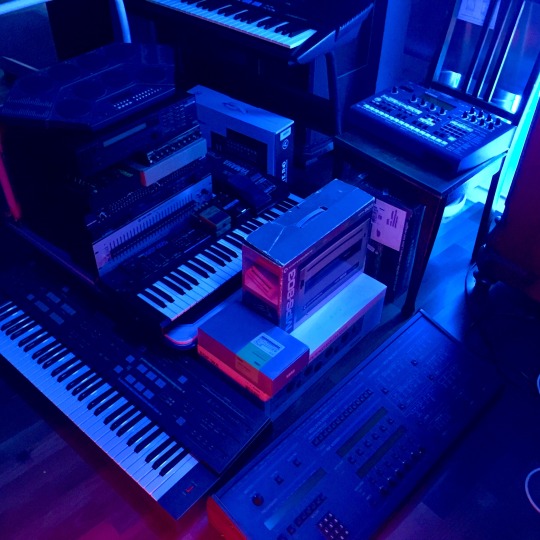
Sold:
Roland D-05 – Generally liked this synths sound, but its inconvenient to program, filters don't work on PCM waveforms, lacks multi-timbrality and no proper outputs. Used on Super Aliasing and other tracks.
Roland TB-03 – Sounds pretty nice, easy to program, but lacks proper outputs. I used this as a harp-like instrument in the end of Void Gate Access Software.
Akai S1000 – Wonderful sounding sampler, but is 1U bigger, has less RAM, half the polyphony probably sells better than the than S3000XL. Used on Void Gate Access Software and Void Gate Panorama Station.
Oberheim Xpander – A really nice instrument, I spent lot of time with, but always made me feel uneasy owning. Expensive, old, analog synths always come with the risk that something breaks. Used on: Ancient Data Tapes, Oberheim Taxi Shagnhai Xpander, Server Room Love Letters, Affinity, Infinity, Protorezoic Ocean, Hexadecimal Love Letters, Offshore Network Vertex, Cyborg Samurai Miyamoto, and many more tracks.
Korg M1R – A great sounding, multi-timbral classic, but while not too complicated, still inconvenient to program, because of it's small display. Also, the Plugin version of it, sounds really good, comes with a great sound library that is well-structured and is more convenient to program. Used on Offshore Network Vertex and a few other tracks but more of the M1 sounds on the album actually stem from the M1 Legacy Plugin.
Korg Volca Beats – Cool device, easy to use, but lacks proper outputs. Used on Offshore Network Vertex and Void Gate Access Software.
Korg Poly 800 II – One of my first hardware synths. Found this for cheap in a thrift-store almost a decade ago. Nice retro sounds. Not pleasant to program, chewy buttons, archaic digital menu. My album Tomes of Erebus was for big parts made on this one. Also used on Void gate Access Software and other tracks.
Casio CZ-5000 – Never really used much but the same, particular self-made patch on this synth (now thoroughly sampled). Used on Cyborg Samurai Miyamoto and a few other tracks.
Yamaha PSR-47 – Non-programmable Keyboard with lots of presets, some of them good. Has MIDI. Used on Screensaver Library. Used on Offshore Network Vertex and other tracks.
Yamaha PSR-60 – Not so fun, non-programmable FM based keyboard thing with MIDI. Used on Screensaver Library.
Yamaha Reface DX – Great sounding 4-OP FM synth, easy to program, proper MIDI and outputs, good keyboard, but that part of the menu is solved with touch controls always annoyed me. Used on Void Gate Access Software, Void Gate Panorama Station and other tracks.
Yamaha Reface CS – Interesting synth, proper outputs and MIDI, lots of sound capabilities, slightly too clean sounding. Sounded great when sampled through Akai S1000. Used on Hexadecimal Love Letters and some other tracks.
Yamaha DX21 – Nice 4-OP FM synth from the era of the DX7. In theory an easy synth, but the small, non-backlit display and the very archaic menu qualities make it annoying to program. Main synth on Wintermute and Personal System/2. Used on a few other tracks too.
Yamaha FB-01 – Interesting multi-timbral FM synth. Patches can not be programmed on-device and is ultimately too generic sounding to keep, compared to YM3812 or PSS-480. Used on Wintermute, Voidnet Online Service Provider and other tracks.
Yamaha TG33 – Interesting synth. Similar to the Roland D-05 / D-50 but FM / PCM based. Kinda headache inducing menus. When weighing up accessibility to sound-capabilities it lost out. Used on: Void Gate Access Software and a few other tracks.
Arturia Miniburte – Great monophonic analog synth. Nice for deep sounds. Used on many tracks. Didn't really fit into the concept of my next setup. Used on Offshore Network Vertex, Void Gate Access Software, Void Gate Panorama Station, Hexadecimal Love Letters and other tracks.
Waldorf Rocket – Interesting synth. Mostly used it for filtering external signals through it's analog filter. Used on: Illustrated History of Nature, Voidnet Online Service Provider, Void Gate Panorama Station and other tracks.
Roland U-110 – PCM sound module. Some nice sounds. Used on PCM Sound Module U-110 and some other tracks.
Conclusion: Most synths I'm keeping are digital, rack-mounted, multi-timbral, 90s devices or some kind of semi-unusual retro computing related thing, reducing the tools to a core-palette of things I really like, for future projects.
Well, that's it for now. An update on current Fornax Void activities. I hope there is some useful info in there for some of you. Will be back with more updates.
Best Regards, Fornax Void
2019-APRIL-22, 20:15, 1555956900
#fornax void#update#news#synthesizer#music#studio#ambient#synth#roland#akai#korg#yamaha#arturia#waldorf#casio#oberheim#commodore#sampler#S3000XL#wavestation#m1r#opl2#opl3#YM3812#minibrute#mssiah#u-110#tg33#fb-01#xpander
94 notes
·
View notes
Audio

New addition to Cyberspace Database: Void Gate Panorama Station Recorded between January and March 2018 with Roland JV-2080, Roland D-05, Akai S1000, Akai S3000XL, Oberheim Xpander, Korg M1R, Korg WaveStation A/D, Korg Poly 800 MK2, Casio CZ-5000, Yamaha PSS-480, Yamaha TG33, Yamaha PSR-47, Yamaha PSR-60, Yamaha Reface CS, Yamaha DX21, Yamaha FB-01, Arturia Minibrute, Waldorf Rocket, REA YM3812 (OPL2), Roland TR505, Commodore 64 with Mssiah, Wayfar MidiNES, Eventide Space.
#space#ambient#cyberpunk#90s#synthesizer#digital#art#roland#musicians on tumblr#artists on tumblr#music#3d#pixel#96 colors#gif
184 notes
·
View notes
Note
Now that you're working on a new release, I'm curious what your (songwriting or composing or whatever you call it) process looks like. Do you start with an idea or concept and work from there, or do you sit down with your synths and tinker with patches until something favorable shows up? Do you have a particular synth you use for sketching, or some default go-to patches? Do you write down or record the MIDI right away or do you tinker with patches first and do the actual writing later? Thanks!
Heythere, thanks for your interest. It’s hard to give an exact answer tothis question. My workflow was constantly changing in recent years,as I slowly built up the setup I ended up working with now. A lot ofthe tracks I released in recent years were sketches – basically megetting used to newly acquired hard- or software. But I’ll justramble on a bit about things that come to my mind, and maybe there will be something in there for you…
Generallyspeaking, most of the music I make is inspired by topics thatinterest me beyond the intention of creating music. Obviously,Vintage Computing and game soundtracks (Deus Ex, DreamWeb, X-ComApocalypse, Uplink, Crusader: No Remorse etc.), the demo scene,tracker music, vintage CG etc. are themes I draw a lot of inspirationfrom. But topics like astronomy, ancient civilizations / history ingeneral can also be very inspiring to me in close connection to mymusic. To have a kind of a general topic or mood for your project isextremely helpful to be able to reduce / calibrate yourself towardsa certain acoustical aesthetic. For example: having noise or sampleswith low sample rates in my music doesn’t bother me in a negative wayas it fits the themes I’ve chosen for my project. This also extendsto other decision problems, for example: I can play the guitar anda bit of drums, but it most often doesn’t fit in my projectsmicrocosm anyway, so I don’t have to bother about it in a way thatmakes me feel obligated to put a guitar or drums in a track. So, like with all creativework, it makes your life easier to reduce yourself to a certainpalette of tools / aesthetics / colors / sounds etc. but I also don’trecommend creating dogmas from this. If there’d be a moment I wannaput an acoustic guitar in a track, I’d just try to make it happen /fit.
When I start a new track, I usually work very sequential,building things up step by step like a house. For me composing andprocessing / recording go hand in hand. Just recording things anddoing the whole EQ / Compressor stuff later with plugins, isn’t whatI’m into at the moment. I try to have everything sounding as close aspossible to what it should, before I hit the record button on a newelement (also a matter of limited resources). This forces me to makedecisions early on. That way I’m ideally not ending up in frontof a huge mass of unprocessed audio and a muddy sounding mix. I’mtrying to place everything in a precise way, like a brick you can’tmove later on (with the advantage that you of course, can still doall the digital post-processing if needed). A bit like photographingwith an analog camera. But you can of course also emulate this kind of workflow when working exclusively with plugins.
Alsowhile I sometimes tend to put too much crap in my tracks, I try tonever forget that things can work perfectly fine with just two oreven one instrument(s) applied in an interesting way.
Allof this naturally overlaps with the creation of patches as well assometimes the choice and adjustment of presets. There are phases(usually to break up the monotony when working on visual stuff) whenI so nothing musically, but learning how my synths work and creatingpatches. When I’m recording a new track I’m then able to zapthrough a number of acoustical ideas. While recording I might want to create specific new patches / adjust patches or presets (editing filter settings so you haveto EQ / compress less, syncing BPM of LFOs to your project, adjustingADSR etc.) so even when starting from presets, it is very helpful tounderstand the synth so you can edit those to fit your needs.
Thiskind of full-circles into the choice of instruments. The mood I wantto achieve / genre(s) I want to explore have a very defining impact onwhat kind of synths I like. I ended up with the hardware I havebecause it mostly fits the category of 80s/90s menu diver / fm /wavetable / sampler / computer kitsch things that I like a lot. Mostof it is also 2nd hand and relatively inexpensive so thisalso fits my resource limit (some exceptions made).

Insteadof actually working on the album I should work on (the one I often use to talk about on here), I’m currentlyfinishing the last steps on a cassette release with two tracksapprox. 18 minutes each. I made a list of synths / samplers etc. Iused on that release:
AkaiS1000
CasioCZ-5000
CasioDG-20
RolandU-110
RolandJV-2080
RolandD-05 (D-50 reissue)
RolandTR-505
RolandTB-03
WaldorfRocket
OberheimXpander
ArturiaMiniBrute
MOSSID 6581 (C64 via mssiah)
MOSSID 8580 (C64C via mssiah)
RICO2A03 (NES PAL via Wayfar MIDINES)
KorgPoly 800 MKII
KorgWaveStation A/D
KorgM1R
KorgVolca Beats
YamahaPSS-480 (!!!)
YamahaDX21
YamahaReface DX
YamahaReface CS
YamahaRX21L
YamahaDD-11
YamahaPSR-47
YamahaPSR-60
YamahaFB-01
YamahaTG-33
Imade my favorites bold. I’ve also put some links to YouTube demos onthere for the ones I knew demos I like. Such gear lists also can beinspirational sometimes.
Then hereare some links to music that does inspire me or have inspired me in thepast on a compositional level:
youtube
youtube
youtube
youtube
youtube
I hit the limit of YouTube embeds. But what I basically want to say is, that for most of the time, I try to keep my intake of music related to what my output should be.
So I have this diffuse cloud of a mood / feeling generated by a compilation of things I’m interested in, that builds the base for most of the choices I make. But I also try the keep things fluid so everything still has some room to evolve inside certain boundaries.
I don’t know how much sense any of this makes, and I don’t claim my way of approaching the creative process to be exemplary, but maybe there is something in there for you or somebody else, that can spend some variable amount of inspiration. I had fun, trying to do a sketchy summary of my thoughts on this topic.
Have a nice weekend!
79 notes
·
View notes